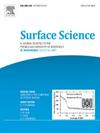Adsorption of trimethylaluminum on period 4 and 5 transition metal surfaces
IF 1.8
4区 化学
Q3 CHEMISTRY, PHYSICAL
引用次数: 0
Abstract
It is known that atomic layer deposition (ALD) of Al2O3 using trimethylaluminum (TMA) on transition metal surfaces is dependent to the type of the metal element, so that only coinage metal surfaces show delayed nucleation. In this study, the molecular and dissociative adsorption of TMA on 20 transition metal surfaces were investigated using density functional theory (DFT) calculations. The adsorption energy of molecular TMA depends on the group numbers of the elements, so that late transition metals are expected to show weaker adsorption of TMA molecule compared to those on early transition metals. Dissociative adsorption of TMA is expected to spontaneously proceed on most transition metal surfaces. However, TMA is expected to have reversible molecular adsorption on the surfaces of Cu, Zn, Ag, and Cd. Together with low propensity toward oxidation, the nucleation delay of Al2O3 ALD on Cu and Ag can be explained.

三甲基铝在周期4和周期5过渡金属表面的吸附
已知三甲基铝(TMA)在过渡金属表面的Al2O3原子层沉积(ALD)取决于金属元素的类型,因此只有铸币金属表面表现出延迟成核。本研究利用密度泛函理论(DFT)计算研究了TMA在20种过渡金属表面的分子和解离吸附。分子对TMA的吸附能取决于元素的基团数,因此晚期过渡金属对TMA分子的吸附比早期过渡金属弱。预计TMA的解离吸附会自发地在大多数过渡金属表面进行。然而,TMA有望在Cu、Zn、Ag和Cd表面具有可逆的分子吸附。再加上低氧化倾向,Al2O3 ALD在Cu和Ag表面的成核延迟可以解释。
本文章由计算机程序翻译,如有差异,请以英文原文为准。
求助全文
约1分钟内获得全文
求助全文
来源期刊

Surface Science
化学-物理:凝聚态物理
CiteScore
3.30
自引率
5.30%
发文量
137
审稿时长
25 days
期刊介绍:
Surface Science is devoted to elucidating the fundamental aspects of chemistry and physics occurring at a wide range of surfaces and interfaces and to disseminating this knowledge fast. The journal welcomes a broad spectrum of topics, including but not limited to:
• model systems (e.g. in Ultra High Vacuum) under well-controlled reactive conditions
• nanoscale science and engineering, including manipulation of matter at the atomic/molecular scale and assembly phenomena
• reactivity of surfaces as related to various applied areas including heterogeneous catalysis, chemistry at electrified interfaces, and semiconductors functionalization
• phenomena at interfaces relevant to energy storage and conversion, and fuels production and utilization
• surface reactivity for environmental protection and pollution remediation
• interactions at surfaces of soft matter, including polymers and biomaterials.
Both experimental and theoretical work, including modeling, is within the scope of the journal. Work published in Surface Science reaches a wide readership, from chemistry and physics to biology and materials science and engineering, providing an excellent forum for cross-fertilization of ideas and broad dissemination of scientific discoveries.
 求助内容:
求助内容: 应助结果提醒方式:
应助结果提醒方式:


